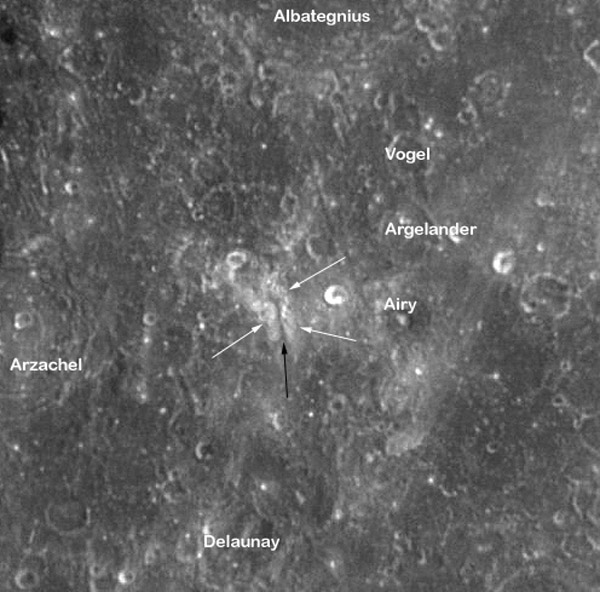Difference between revisions of "July 29, 2014"
(Created page with "__NOTOC__ =Airy Swirl= <!-- ws:start:WikiTextHeadingRule:0:<h1> --> <!-- ws:start:WikiTextLocalImageRule:6:<img src="/file/view/LPOD-Feb10-08.jpg/34852263/LP...") |
|||
| Line 2: | Line 2: | ||
=Airy Swirl= | =Airy Swirl= | ||
| − | + | <!-- ws:start:WikiTextHeadingRule:0:<h1> --> | |
| − | + | <!-- ws:start:WikiTextLocalImageRule:6:<img src="/file/view/LPOD-Feb10-08.jpg/34852263/LPOD-Feb10-08.jpg" alt="" title="" /> -->[[File:LPOD-Feb10-08.jpg|LPOD-Feb10-08.jpg]]<!-- ws:end:WikiTextLocalImageRule:6 --><br /> | |
<em>image by [mailto:HowardEskildsen@msn.com Howard Eskildsen]</em><br /> | <em>image by [mailto:HowardEskildsen@msn.com Howard Eskildsen]</em><br /> | ||
<br /> | <br /> | ||
| − | + | As soon as I started seriously observing the full moon, I noticed this strange, bright-albedo feature east of Arzachel and wondered what possibly could have caused it. It is stands out at high sun angles, even at low power views of the full moon, and I was surprised that I had never seen it mentioned before. Later, I ran across a couple of references that suggest that it is a lunar swirl associated with a magnetic anomaly. It appears to have been first described as the "Airy Swirl" in a short 2006 [http://www.lpi.usra.edu/meetings/lpsc2006/pdf/1230.pdf paper] by Hughes, Blewett, Hawke, and Richmond. White arrows on the labeled photo point to the bright margins of the swirl and the dark arrow points to the dark lane between the bright features. This area is truly intriguing and deserves further study. <br /> | |
<br /> | <br /> | ||
<em>Howard Eskildsen<br /> | <em>Howard Eskildsen<br /> | ||
| Line 19: | Line 19: | ||
<br /> | <br /> | ||
<hr /> | <hr /> | ||
| − | |||
| − | |||
| − | |||
| − | |||
Revision as of 01:04, 3 January 2015
Airy Swirl

image by Howard Eskildsen
As soon as I started seriously observing the full moon, I noticed this strange, bright-albedo feature east of Arzachel and wondered what possibly could have caused it. It is stands out at high sun angles, even at low power views of the full moon, and I was surprised that I had never seen it mentioned before. Later, I ran across a couple of references that suggest that it is a lunar swirl associated with a magnetic anomaly. It appears to have been first described as the "Airy Swirl" in a short 2006 paper by Hughes, Blewett, Hawke, and Richmond. White arrows on the labeled photo point to the bright margins of the swirl and the dark arrow points to the dark lane between the bright features. This area is truly intriguing and deserves further study.
Howard Eskildsen
This is a repeat of an LPOD from Feb 10, 2008. This is a way to congratulate Howard for his article in the new issue of S&T!
Technical Details
Dec 21, 2007, 23:49 UDT, Meade 6" f/8 refractor, 2X Barlow, Orion StarShoot II, Seeing 5/10, Clarity 4/6
Argelander D is the small bright crater near the center of the image.
Related Links
21st Century Atlas chart 12.



